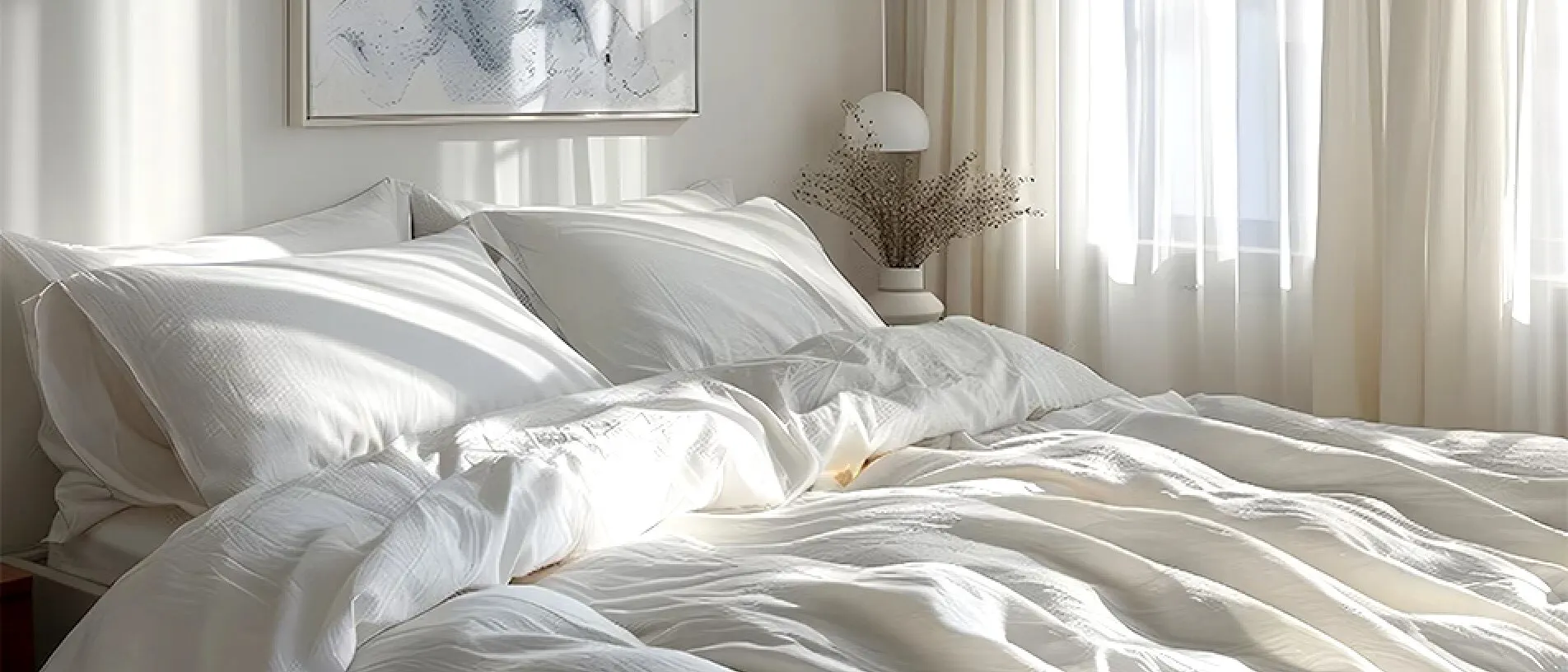You're on the list
By signing up, you agree to receive email marketing.

The quality of your bed sheets can make or break your sleeping experience. There’s nothing more relaxing than cozying up in luxurious and soft sheets. By contrast, hot or scratchy bedding can lead to uncomfortable and sleepless nights.
Investing in the right bedding will help you enjoy the peaceful rest you deserve. But what is the best material for bed sheets? This guide covers the most common types, their pros and cons, and other factors to consider.
Spend a few minutes shopping for bed sheets online, and you’ll discover thousands of options. You can easily pick the appropriate size based on your mattress’s dimensions, and certain colors may fit your aesthetic. However, choosing the right fabric can be more challenging.
Understanding the pros and cons of these common materials will help you choose the best fabric for bed sheets.
Manufacturers weave cotton from the soft, fluffy fibers of cotton plants. It’s the most common fabric for bedspreads, sheets, and other bedding materials. Bed sheets come in several types of cotton, including:
Egyptian cotton: This fine cotton is grown and handpicked in Egypt. It’s often considered the most high-quality and softest cotton.
Supima cotton: This premium fabric is grown from American Pima cotton. It’s renowned for its exceptional durability and strength.
Cotton jersey: This fabric is knitted from cotton instead of woven like other cotton fabrics. The knitting process makes the cotton stretchier and more breathable. Some cotton jersey sheets are made from 100% cotton, while others are made from mixtures of cotton and synthetic materials.
Flannel: This warm material is typically made from brushed cotton or wool.
Moisture absorbent
Naturally breathable for all-night comfort
Widely available
Can be challenging to assess the quality
High-quality cotton sheets can be expensive
May degrade faster than linen or synthetic sheets
Prone to wrinkling
Linen is a natural fabric woven from the fibers of the flax plant. Unlike cotton, new linen can feel crisp or scratchy. However, washing linen gradually breaks down the flax fibers, so the linen softens over time. You can speed up this process by choosing pre-washed linen sheets.
Bacteria resistant
Allergy resistant
Lasts for many years when properly maintained
May not provide enough warmth for cold climates
More expensive than other fabrics
Prone to wrinkling
Silk is a lustrous fabric made from the cocoons of silkworms. This material feels extremely soft and smooth, so manufacturers often use it to create high-end bedding.
Silk sheets are much more delicate than other bedding materials. You can extend their lifespan by cleaning them carefully. Only wash silk sheets in cold water by hand or using your washer’s delicate setting. Place the sheets in a mesh bag to prevent rips, and air dry them afterward.
Incredibly comfortable and luxurious
Provides natural temperature regulation
High maintenance
One of the most expensive bedding materials
Microfiber is woven from ultrafine fibers made from polyester, nylon, or other synthetic materials. It is typically inexpensive and comes in a wide range of colors and patterns. Microfiber sheets are also strong and stain-resistant, making them popular for children’s bedding.
Affordable
Easy to maintain
Moisture wicking
Not prone to wrinkling or shrinking
Can trap heat
Less durable than natural fabrics
Bamboo sheets are made from the pulp of the bamboo plant. Manufacturers smash the stalks, melt them into a pulp, and extract a cellulose fiber called bamboo rayon. They spin this material into yarn and weave it into bed sheets.
Many people prefer bamboo sheets for their breathability and ability to regulate temperature. This material also repels bacteria and other microbes, reducing odor between washes.
Easy to maintain
Moisture wicking
Soft texture
Have limited colors and patterns
More expensive than cotton and microfiber
Prone to wrinkling
Thread count is another factor to consider when shopping for bedding. Here’s the ideal thread count for each type of fabric:
Cotton: 300 to 500
Linen: 80 to 220
Silk: 22 to 25 momme
Microfiber: Over 100 grams per square meter
Bamboo: 250 to 350
Some people use the terms weave and thread content interchangeably, but they refer to different parts of the fabric.
The weave refers to the specific technique used to create the fabric. For example, percale sheets have a tightly woven crisscross pattern that gives them a smooth texture. Meanwhile, manufacturers weave sateen sheets by wrapping several threads over the warp yarns, creating a glossy and soft surface.
The thread count refers to the number of fabric strands per square inch of material. A higher density of threads leads to a softer texture.
Many people get hot at night, especially during the summer. If you’re a hot sleeper, look for thin cotton, linen, or silk sheets. These lightweight fabrics have moisture-wicking properties to reduce late-night sweating. They’re also breathable, so they release heat emitted by your body.
Cozy and warm bed sheets will help you sleep in cold climates. The top fabrics for chilly environments include flannel and heavyweight cotton. These dense materials feel extremely soft and retain heat to keep you snug all night. Add a cotton comforter or duvet if you need extra warmth.
The best material for bed sheets varies depending on your sleeping preferences and needs. Natural materials like cotton and linen are biodegradable, durable, and soft. Meanwhile, microfiber sheets might suit people who want affordable, low-maintenance sheets.
You're on the list
By signing up, you agree to receive email marketing.